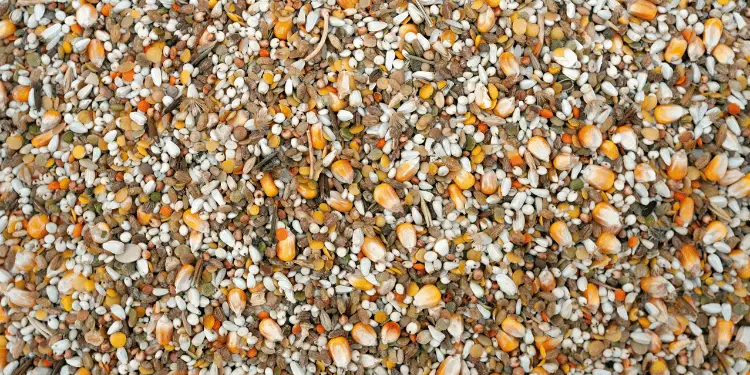Winter Bird Feeding 101: Complete Guide to Keeping Wild Birds Safe and Fed
Anúncios
Introduction to Winter Bird Feeding
Feeding birds during the cold winter months is not only a heartwarming endeavor but also a crucial support to our feathered friends.
As the temperatures drop and natural food sources become scarce, your backyard can become a sanctuary for birds seeking sustenance to survive the harsh weather.
Anúncios
Importance of Feeding Birds During Cold Winter Months
Winter is a challenging time for birds. With snow covering the ground and insects becoming dormant, it can be nearly impossible for birds to find adequate food.
Providing food during this critical period ensures birds have the energy to withstand the cold and continue their daily activities.
Anúncios
Feeding birds during winter also supports their migration journeys, which can be demanding and energy-draining.
Considerations and Precautions When Feeding Wild Animals
While feeding birds helps them survive, it’s important to do so thoughtfully.
The U.S. Fish and Wildlife Service advises against teaching wild animals to associate humans with handouts, as it can lead to dependency and problematic behaviors.
To feed birds safely:
- 🪶Avoid placing food too close to your home to prevent birds from becoming too reliant on human presence.
- 🪶 Use feeders that are durable and weather-resistant to keep the food dry and fresh.
- 🪶 Be mindful of the types of foods you offer. Stick with bird-safe options like commercially mixed bird seed, black-oil sunflower seeds, and suet cakes.
Benefits of Supporting Bird Populations During Scarce Food Periods
Supporting bird populations in winter has numerous benefits for both the birds and the environment.
Birds play a vital role in maintaining ecological balance by pollinating plants, dispersing seeds, and controlling insect populations.
During periods when food is scarce, your efforts can make a significant difference in their survival, contributing to a healthier and more vibrant ecosystem.
Moreover, feeding birds provides an opportunity to observe their behaviors and enjoy the beauty and diversity of local bird species.
It can be a soothing and educational experience for families, fostering a deeper connection with nature.
Remember, while feeding birds during winter is incredibly beneficial, it’s essential to do so responsibly.
Keep feeders clean, provide fresh water, and use the right types of food to prevent the spread of disease and ensure the birds’ well-being.
Up next, we’ll delve into selecting the right food for your winter bird visitors, ultimately enhancing their survival and enriching your bird-watching experience.
Selecting the Right Food
When it comes to feeding birds during the winter months, choosing the right food is crucial to ensuring they get the necessary nutrients to survive.
In this chapter, we’ll explore various food options and their benefits, helping you make the best choices for your feathered visitors.
 Seeds are one of the options
Seeds are one of the options
Commercially Mixed Bird Seed
Commercially mixed bird seeds are a popular choice because they cater to a wide variety of bird species.
These mixes typically include a combination of millet, cracked corn, nyjer seeds, and sometimes peanuts.
This variety ensures that different birds can pick their preferred types of seeds, encouraging a more diverse bird population in your yard.
You can easily find these mixes at local hardware stores, supermarkets, and wholesale clubs.
Black-Oil Sunflower Seeds
A favorite among bird enthusiasts, black-oil sunflower seeds are highly recommended for winter feeding.
These seeds have a high meat-to-shell ratio and are rich in healthy fats, making them an excellent energy source for birds during the cold months.
Moreover, their thin shells are easy for birds to crack open, attracting a wide range of species, including chickadees, nuthatches, and finches.
If you’re looking to purchase just one type of seed, black-oil sunflower seeds might be your best bet.
Specialty Foods: Suet Cakes and Seed Bells
For an extra treat, consider specialty bird foods like suet cakes and seed bells.
Suet cakes are made from beef fat mixed with seeds, cornmeal, peanuts, or even mealworms, providing a high-energy snack that helps birds stay warm.
These cakes can be found in most stores that sell bird seed and are typically placed in simple square cages.
Seed bells, on the other hand, are combinations of seeds held together by an edible gelatin, making them an easy and convenient option for bird feeding.
They can be hung from trees or posts and are particularly great for attracting smaller birds who might struggle with larger feeders.
By selecting the right food, you can provide essential support for bird populations during the winter months.
Our next step is understanding the various types of bird feeders to ensure your feeding efforts are successful and safe for the birds.
Types of Bird Feeders
Feeding wild birds during the cold winter months can be a rewarding experience.
To do it effectively, it’s crucial to know the different types of bird feeders available.
Each type serves a unique purpose and caters to various bird species. Let’s explore the three main types: hopper, tube, and tray feeders.
Hopper Feeders
Hopper feeders, also known as house feeders, are versatile and can accommodate various bird species.
These feeders are designed with a container that holds a substantial amount of seed.
When birds perch on the feeder and peck at the feeding ports, the seeds are dispensed.
Hopper feeders can be hung from tree branches or poles.
Benefits:
- 🪶 Holds a large quantity of seed, reducing the need for frequent refills.
- 🪶 Protects seeds from the elements, keeping them dry and fresh.
- 🪶 Attracts larger birds and multiple species.
Considerations:
- 🪶 Ensure the structure is sturdy and weather-resistant to withstand harsh winter conditions.
- 🪶 Place multiple hopper feeders several feet apart to prevent overcrowding and aggression among birds.
Tube Feeders
Tube feeders are long, cylindrical feeders with multiple feeding ports.
They are great for attracting smaller bird species such as finches, chickadees, and sparrows.
These feeders can be hung from trees or posts, making them suitable for various locations in your yard.
Benefits:
- 🪶 Multiple feeding ports allow several birds to feed simultaneously.
- 🪶 Easy to clean and refill.
- 🪶 Ideal for seed mixes or black-oil sunflower seeds.
Considerations:
- 🪶 Ensure the feeding ports are designed to accommodate the size of the seeds you are using.
- 🪶 Opt for durable and weather-resistant materials to extend the feeder’s lifespan.
Tray Feeders
Tray feeders, also known as platform feeders, are simple and accessible.
They consist of a flat tray where seeds or other foods are placed.
Tray feeders can be placed low to the ground, attached to stumps, or mounted on deck railings.
Benefits:
- 🪶 Offers an open and accessible feeding area for birds.
- 🪶 Attracts ground-feeding birds such as juncos and doves.
- 🪶 Easy to clean and monitor seed levels.
Considerations:
- 🪶 Ensure the tray has proper drainage to prevent seed spoilage.
- 🪶 Place multiple tray feeders in different areas to reduce competition among birds.
Durability and Weather Resistance
When selecting feeders, prioritize those made from durable and weather-resistant materials.
Feeders constructed from metal, heavy-duty plastic, or treated wood are ideal choices.
These materials can withstand freezing temperatures, snow, and ice, ensuring your feeders remain functional throughout the winter.
Preventing Overcrowding
Overcrowding at feeders can lead to aggressive behavior and the spread of disease among birds.
To mitigate this, place multiple feeders in different locations around your yard.
Space them several feet apart to give birds enough room to feed comfortably.
This not only promotes a healthier environment for the birds but also enhances your bird-watching experience.
By understanding the different types of bird feeders and their unique benefits, you can create an inviting and safe feeding space for winter birds.
Proper placement and regular maintenance will ensure the health and well-being of your avian visitors.
Proper Feeder Placement
Ensuring proper feeder placement is crucial to protect the birds you’re trying to help.
Inappropriate placement can lead to accidents, predation, and overall ineffectiveness of your bird-feeding efforts.
Avoiding Window Collisions
It’s estimated that up to 100 million birds are killed every year from collisions with window glass.
To minimize this risk, bird feeders should be placed either less than 3 feet or more than 30 feet from windows.
- 🪶 Under 3 Feet: A feeder situated close to a window doesn’t allow birds to build up the momentum needed for a fatal collision.
- 🪶 Over 30 Feet: At this distance, any reflections in the window that might confuse the birds become less significant, reducing the chances of an accidental hit.
Proximity to Trees and Shrubs
Birds need to feel safe while they eat.
Trees and shrubs offer vital resting places between feeding bouts and crucial escape routes if predators approach.
Ideally, placing feeders about 10 feet from these natural covers is beneficial:
- 🪶 Safety: Trees and shrubs provide a quick hideaway for birds in the event of a predator attack.
- 🪶 Balance: However, setting up feeders too close to trees might inadvertently aid predators like cats or squirrels. Therefore, keeping a distance of around 10 feet is often a good compromise.
Protecting Birds from Predators
Consideration of predators is crucial for feeder placement. Birds must feel safe when they visit your backyard for food.
Here are strategies to minimize their risk:
- 🪶 Height and Accessibility: Install feeders at heights that are difficult for predators to reach, ideally hanging them from sturdy poles or tree branches.
- 🪶 Baffles and Guards: Utilize baffles and guards on feeder poles to deter climbing predators such as cats and squirrels. These barriers can make it impossible for these animals to reach the feeder.
Wrapping Up Proper Feeder Placement
Proper positioning of bird feeders involves thoughtful consideration of distance from windows to avoid deadly collisions, proximity to trees for safe perching, and adequate measures to protect birds from potential predators.
These steps will help create a safe and welcoming environment for birds, ensuring they benefit from the food you provide.
By perfecting your feeder placement, you set the stage for a safer, more comfortable bird-feeding setup, making it easier for the birds to flock to your yard safely.
Maintenance and Water Supply
With proper bird feeder placement in mind, it’s essential to turn our attention to maintenance and supplying water to our feathered friends.
Keeping feeders clean and providing an adequate water source during winter months can have a substantial impact on bird health.
Regular Cleaning Schedule
Consistent maintenance of bird feeders is pivotal for the health and well-being of wild birds.
Feeders should be cleaned every two weeks using soap and water to prevent the spread of diseases.
Ensure to rinse them thoroughly and allow them to dry completely before refilling.
This cleaning routine minimizes the transmission of infectious diseases among the bird population, maintaining their health during challenging winter months when they congregate around feeders.
Water Provision Options
In the winter, water sources can be scarce for birds due to frozen ponds and streams, making it even more crucial to provide accessible and safe water for them.
Here are some practical options:
- 🪶 Heavy-duty plant saucers: These saucers are sturdy and can withstand freezing temperatures. Empty the ice and refill them with water each morning to ensure a steady supply.
- 🪶 Heated birdbaths: For a more consistent and low-maintenance option, consider using heated birdbaths. These devices keep the water from freezing and are easily available at many stores.
Importance of Providing Perching Rocks and Sunny Placement
The placement of your water sources is just as important as the water itself.
Position birdbaths in sunny areas to take advantage of the natural warmth during winter days. Adding perching rocks around the edges of the baths provides birds with secure places to stand while they drink.
This not only makes it easier for them to access the water but also helps to keep the water cleaner by reducing the risk of birds stepping directly into it.
Regular maintenance and thoughtful water provision can significantly enhance the support you offer to bird populations during winter.
Ensuring they have access to clean feeders and a reliable water source will help them thrive despite harsh conditions.







